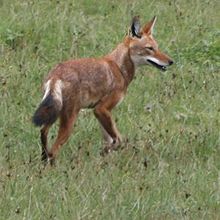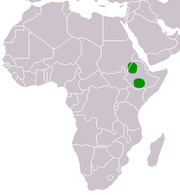
Ethiopian wolf
Background Information
This wikipedia selection has been chosen by volunteers helping SOS Children from Wikipedia for this Wikipedia Selection for schools. SOS Child sponsorship is cool!
| Ethiopian Wolf Temporal range: Pliocene - Recent |
|
|---|---|
 |
|
| Conservation status | |
|
Critically Endangered ( IUCN 2.3) |
|
| Scientific classification | |
| Kingdom: | Animalia |
| Phylum: | Chordata |
| Class: | Mammalia |
| Order: | Carnivora |
| Family: | Canidae |
| Genus: | Canis |
| Species: | C. simensis |
| Binomial name | |
| Canis simensis Ruppell, 1840 |
|
 |
|
| Ethiopian Wolf range (OBS: Contrary to this map, its range does not extend into E. Sudan). | |
The Ethiopian wolf (Canis simensis) is a carnivorous mammal of the family Canidae. It is also known as the Abyssinian wolf, red jackal, red fox, Simien fox or Simien jackal). The numerous names reflect previous uncertainty about its taxonomic position, but it is now thought to be related to the wolves of the genus Canis rather than the foxes it superficially resembles. The Ethiopian wolf is found in the Afro- alpine regions of Ethiopia, about 10,000 feet (3,000 meters) above sea level. It is the most endangered canid, with only about seven populations remaining, totalling roughly 550 adults. The largest population is found in the Bale Mountains in southern Ethiopia, although there are also smaller populations in the Simien Mountains in the north of the country, and in a few other areas. Claudio Sillero-Zubiri at the University of Oxford is the zoologist most closely associated with efforts to save this species of wolf, particularly with his work for an oral rabies vaccine to protect them from the disease passed from local dogs. His work is supported by the Born Free Foundation. A rabies outbreak in 1990 reduced the largest known population, found in the Bale Mountains National Park, from about 440 wolves to less than 160 in only two weeks.
Taxonomy and evolution
Initial molecular evidence suggested that the Ethiopian wolf is a descendant of the grey wolf. More recent evidence suggests that this is not the case; although the Ethiopian wolf is closely related to other wolves, it probably diverged some three or four million years ago.
Description
The Ethiopian wolf is a medium sized canid resembling the coyote in size and conformation, having long legs and a narrow pointed muzzle. It weighs 11-19 kilograms (24-42 pounds), with males being 20% larger than females. The skull has a flat profile with a thick, narrow and low neuro-cranium which is almost cylindrical in shape. The coronal ridge is linear and the inter- parietal bone slightly developed. The teeth are small and widely spaced, an adaptation to their rodent heavy diet. The dental formula is 3/3-1/1-4/4-2/3=42. The back molars are occasionally absent. The canine teeth are sharply pointed and average 19 millimetres in length. The ears are pointed and broad, sporting thickly fringed pinnae. The front feet have five toes, while the back have four.
The coat is ochre to rusty red on the face, ears and upper portions of the body and white to pale ginger on the underparts. Small white spots are present on the cheeks, as well as a white ascending crescent below the eyes. The contrast of red and white markings increases with age and social rank. Females tend to have paler coats. The back of the tail has a short, rufus coloured stripe which ends in a thick brush of black guard hairs on the tip. The pelt has short guard hairs and thick underfur which protect the wolf from temperatures as low as -15 degrees.
Social behaviour
Although the Ethiopian wolf is primarily a solitary hunter of rodents, it lives in packs that share and defend an exclusive territory. This differs from most larger social carnivores that live in groups for the purpose of hunting cooperatively. In areas with little human interference, packs may average 6 adults, 1-6 yearlings, and 1-7 pups. Typically, packs are an extended family group formed by all males born into the pack during consecutive years and 1-2 females. One study showed that the sex ratio of adult pack members in optimal habitat was biased toward males by a ratio of 2.6:1.
Social gatherings among different packs are more common during the breeding season, and take place in close proximity to the den. Ethiopian wolves become highly vocal during these interactions, which invariably end with the smaller group retreating from the larger. Males do not disperse from their natal pack, while females will leave at the age of two years, joining another pack should a breeding vacancy occur.
Reproduction
Within the pack, the dominant female discourages attempts to mate with her from all but the pack's dominant male, though she is receptive to any wandering male from a neighboring group. Up to 70% of all matings involve males from outside the pack. All members of the pack assist in caring for the pups, with subordinate females sometimes assisting the dominant female in suckling the pups. Females breed no more than once annually and give birth to litters usually consisting of 2-6 pups which are born after a 2 month gestation period. Females give birth in a den dug on open ground, under a boulder or within a rocky crevice. Adults will regularly shift pups between dens, up to 1300 m (4300') apart.
Dietary habits
The diet of the Ethiopian wolf is almost exclusively composed of diurnal rodents. One study revealed that rodents account for 96% of all prey, with the endemic giant mole rat being the main food item. In areas where the giant mole rat is absent, the wolf will primarily subsist on the East African mole rat. Other recorded prey species include the black-clawed brush-furred rat, Blick's grass rat, various vlei rats, the yellow-spotted brush-furred rat, young birds, the Ethiopian Highland hare, the Cape hyrax and young of the common duiker, mountain reedbuck and mountain nyala. Sedge leaves are sometimes eaten to aid digestion.
Subspecies
There are two recognized subspecies of this canid:
- Canis simensis simensis; Occurs north-west of the Rift valley. Its nasal bones are shorter than those of the southern race.
- Canis simensis citernii; Occurs south-east of the Rift valley. Its coat is redder than that of the northern race.
Relationships with humans
Cultural significance
Unlike the grey wolf, the Ethiopian wolf is barely touched upon in the folklore or tradition of the human cultures with which it coexists, though the species is mentioned in Ethiopian literature dating back the 13th century. Currently, the Ethiopian wolf is a national symbol, having been used in two stamp series. There are not many traditional uses for the Ethiopian wolf, though its liver may be used for medicinal reasons in the northern regions of the country.
Livestock predation
Though in the past the Ethiopian wolf was feared as a livestock predator, today it is not usually considered a major threat to livestock, to the point where sheep and goats are sometimes left unnattended in areas where wolves occur. In the southern highlands, losses caused by wolf predation are mostly dismissed due to the rarity of such events when compared to predation by the spotted hyena and jackals.
Persecution
Although officially a protected species, wolf killings increased in frequency during Ethiopia's period of instability due to the increased availability of firearms. Ethiopian wolves are not usually exploited for fur, though there was an occasion in Wollo in which wolf skins were used as saddle pads.
